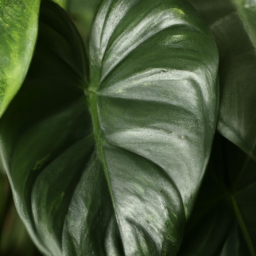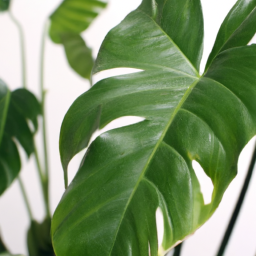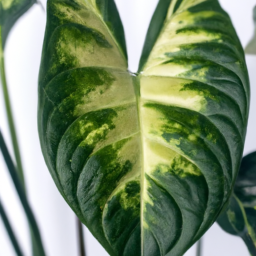
Are you looking to add some greenery to your home but not sure where to start? Philodendron house plants are a great option for beginners and experienced plant enthusiasts alike. In this blog post, we will explore the various types of philodendron house plants available, from the classic heartleaf philodendron to the exotic pink princess philodendron. Whether you’re looking for a low-maintenance plant or a statement piece for your living room, there’s a philodendron variety that’s perfect for you. Let’s dive in and discover the beauty and diversity of these popular house plants.
Common Types of Philodendron House Plants
Heartleaf Philodendron
Overview
The Heartleaf Philodendron, also known as Philodendron hederaceum, is one of the most popular and easy-to-care-for house plants. It has heart-shaped leaves that can grow up to 2 feet long, making it a great choice for hanging baskets or climbing up a trellis. This plant is known for its air-purifying qualities, making it a perfect addition to any indoor space.
Care Tips
To care for your Heartleaf Philodendron, make sure to place it in indirect sunlight and water it when the top inch of soil feels dry. It thrives in average room temperatures and high humidity levels, so misting the leaves occasionally can help keep it healthy. Regularly prune the plant to encourage new growth and prevent it from becoming leggy.
Propagation
You can easily propagate your Heartleaf Philodendron by taking stem cuttings and rooting them in water or soil. Make sure to choose a healthy stem with at least two nodes, and place it in a warm, bright location to encourage root growth. Once roots have formed, you can transplant the cutting into a new pot with well-draining soil.
Silver Satin Philodendron
Overview
The Silver Satin Philodendron, or Philodendron brandtianum, is a stunning variety with velvety, silver-green leaves that have a satin-like sheen. This plant is a slow grower but can reach impressive lengths if given proper care. It thrives in bright, indirect light and can tolerate lower humidity levels compared to other philodendron species.
Care Tips
To care for your Silver Satin Philodendron, place it in a location with bright, indirect sunlight and water it when the top inch of soil feels dry. Avoid overwatering, as this can lead to root rot. Regularly dust the leaves with a damp cloth to keep them clean and free from pests. Fertilize the plant during the growing season to encourage healthy growth.
Propagation
Propagation of the Silver Satin Philodendron can be done through stem cuttings or division. To propagate through stem cuttings, choose a healthy stem with at least two nodes and place it in water or soil to encourage root growth. For division, carefully separate the plant into smaller sections, making sure each section has roots attached before replanting in fresh soil.
Split-Leaf Philodendron
Overview
The Split-Leaf Philodendron, also known as Philodendron bipinnatifidum or Monstera deliciosa, is a striking plant with large, glossy leaves that have unique splits and holes. This plant is a favorite among interior designers for its tropical appearance and dramatic foliage. It requires bright, indirect light and regular watering to thrive.
Care Tips
To care for your Split-Leaf Philodendron, place it in a location with bright, indirect sunlight and water it when the top inch of soil feels dry. Mist the leaves regularly to increase humidity levels and prevent the tips from browning. Rotate the plant occasionally to ensure even growth and dust the leaves to keep them clean and healthy.
Propagation
Propagation of the Split-Leaf Philodendron is best done through stem cuttings. Choose a healthy stem with at least two nodes and place it in water or soil to encourage root growth. Once roots have formed, you can transplant the cutting into a new pot with well-draining soil. This plant can also be propagated through air layering for larger, more mature specimens.

Popular Varieties of Philodendron for Indoor Gardening
Heartleaf Philodendron
One of the most popular types of philodendron for indoor gardening is the Heartleaf Philodendron. This plant is known for its heart-shaped leaves that can grow up to 2 feet long. It is a low-maintenance plant that thrives in low light conditions, making it perfect for indoor spaces with limited sunlight. The Heartleaf Philodendron is also a great air purifier, helping to remove toxins from the air.
When caring for a Heartleaf Philodendron, it is important to water it regularly, allowing the soil to dry out slightly between waterings. This plant does well in a variety of temperatures, but it prefers warmer environments. Fertilize the plant every 6-8 weeks during the growing season to promote healthy growth.
Propagation of the Heartleaf Philodendron is easy, as it can be done through stem cuttings. Simply cut a section of the stem with at least one leaf node and place it in water until roots develop. Once roots have formed, the cutting can be planted in soil to grow into a new plant.
Split-Leaf Philodendron
The Split-Leaf Philodendron, also known as Monstera deliciosa, is another popular variety for indoor gardening. This plant is characterized by its large, glossy green leaves that have unique splits and holes. The Split-Leaf Philodendron is a fast-growing plant that can reach impressive sizes, making it a striking addition to any indoor space.
When caring for a Split-Leaf Philodendron, it is important to provide it with bright, indirect light. Direct sunlight can cause the leaves to burn, so it is best to place this plant near a window with sheer curtains. Water the plant when the top inch of soil is dry, and mist the leaves occasionally to increase humidity.
Propagation of the Split-Leaf Philodendron can be done through stem cuttings or air layering. To propagate through stem cuttings, simply cut a section of the stem with at least one node and place it in water until roots develop. For air layering, make a small incision in the stem and wrap it in moist sphagnum moss until roots form.
Philodendron Brasil
The Philodendron Brasil is a vibrant variety of philodendron that features green heart-shaped leaves with yellow variegation. This plant is easy to care for and can thrive in a variety of light conditions, from low to bright indirect light. The Philodendron Brasil is a great choice for beginners looking to add a pop of color to their indoor garden.
When caring for a Philodendron Brasil, it is important to water it when the top inch of soil is dry. This plant prefers higher humidity levels, so misting the leaves regularly can help promote healthy growth. Fertilize the plant every 4-6 weeks during the growing season to provide it with essential nutrients.
Propagation of the Philodendron Brasil can be done through stem cuttings. Simply cut a section of the stem with at least one node and place it in water until roots develop. Once roots have formed, the cutting can be planted in soil to grow into a new plant.

Identifying Different Types of Philodendron House Plants
Understanding the Variety of Philodendron House Plants
Philodendron house plants are a popular choice for indoor gardening enthusiasts due to their beautiful foliage and low maintenance requirements. There are many different types of philodendron plants, each with their own unique characteristics and care needs. By familiarizing yourself with the various types of philodendron house plants, you can choose the perfect plant to add to your indoor garden.
One of the most common types of philodendron house plants is the heartleaf philodendron (Philodendron hederaceum). This plant features heart-shaped leaves that can vary in color from dark green to a vibrant lime green. The heartleaf philodendron is a versatile plant that can thrive in a variety of lighting conditions, making it a great choice for beginners.
Another popular type of philodendron house plant is the philodendron selloum (Philodendron bipinnatifidum). This plant has large, lobed leaves that give it a tropical appearance. The philodendron selloum is a bit more demanding in terms of care, requiring bright, indirect light and regular watering. However, with the right conditions, this plant can grow to be quite large and impressive.
For those looking for a more compact philodendron option, the philodendron micans is a great choice. This plant features velvety, dark green leaves with a hint of coppery red on the undersides. The philodendron micans is a trailing plant that is perfect for hanging baskets or as a trailing accent in a larger arrangement. This plant thrives in bright, indirect light and prefers to dry out slightly between waterings.
Caring for Different Types of Philodendron House Plants
When it comes to caring for philodendron house plants, there are a few key factors to keep in mind. First and foremost, philodendrons prefer bright, indirect light. Placing your plant near a window where it can receive filtered sunlight is ideal. Avoid placing your philodendron in direct sunlight, as this can scorch the leaves.
In terms of watering, philodendrons prefer to dry out slightly between waterings. This means allowing the top inch or so of soil to dry out before watering again. Overwatering can lead to root rot, so it’s important to let your plant’s soil dry out between waterings. Additionally, philodendrons benefit from regular misting to increase humidity levels around the plant.
Fertilizing your philodendron house plants is also important for their overall health and growth. During the growing season (spring and summer), you can fertilize your plant every 4-6 weeks with a balanced liquid fertilizer. Be sure to follow the instructions on the fertilizer packaging to avoid over-fertilizing your plant.
Propagation and Repotting of Philodendron House Plants
One of the great things about philodendron house plants is that they are relatively easy to propagate. You can propagate your philodendron by taking stem cuttings and rooting them in water or soil. Simply cut a 4-6 inch section of stem with at least one leaf node, remove the lower leaves, and place the cutting in water or soil. Roots should begin to form within a few weeks, at which point you can transplant the cutting into a new pot.
Repotting your philodendron house plants is also important for their overall health and growth. As your plant grows, it may become root-bound in its current pot, which can restrict growth. When repotting your philodendron, choose a pot that is 1-2 inches larger in diameter than the current pot. Be sure to use well-draining soil to prevent waterlogged roots.
By familiarizing yourself with the different types of philodendron house plants and their care needs, you can successfully grow these beautiful plants in your indoor garden. With the right lighting, watering, and fertilizing routine, your philodendron house plants will thrive and bring beauty to your home for years to come.
Here are the Essential Points
If you’re looking to add some greenery to your home, philodendron house plants are a great option to consider. There are several different types of philodendrons to choose from, each with its own unique characteristics. The heartleaf philodendron, for example, is known for its heart-shaped leaves and easy care requirements, making it a popular choice for beginners. On the other hand, the split-leaf philodendron, also known as the monstera deliciosa, features large, dramatic leaves that can add a tropical touch to any room.
Another popular type of philodendron is the Brasil philodendron, which has striking green and yellow variegated leaves that can brighten up any space. For those looking for a more compact option, the micans philodendron is a great choice, with its velvety, deep green leaves and trailing vines. No matter which type of philodendron you choose, these plants are sure to add a touch of natural beauty to your home while also purifying the air and promoting a sense of well-being.
FAQ Compilation:
Q1. What are the different types of Philodendron house plants?
A1. There are several popular types of Philodendron house plants, including the Philodendron Brasil, Philodendron Birkin, Philodendron Heartleaf, Philodendron Micans, and Philodendron Selloum.
Q2. What are the care requirements for Philodendron house plants?
A2. Philodendron house plants thrive in bright, indirect light and well-draining soil. They should be watered when the top inch of soil is dry, and misting the leaves can help increase humidity levels.
Q3. How often should I fertilize my Philodendron house plant?
A3. It is recommended to fertilize your Philodendron house plant every 2-4 weeks during the growing season (spring and summer) with a balanced liquid fertilizer diluted to half strength.
Q4. Can Philodendron house plants be toxic to pets?
A4. Yes, Philodendron house plants are toxic to pets if ingested. It is important to keep them out of reach of pets and children to avoid any potential harm.
Q5. How can I propagate my Philodendron house plant?
A5. Philodendron house plants can be easily propagated through stem cuttings. Simply cut a section of stem with a node and place it in water or moist soil until roots develop.
Dr. Olivia Green is a botanist with over two decades of experience in indoor plant cultivation. She holds a Ph.D. in Plant Biology and has dedicated her career to researching plant behavior in controlled environments. Dr. Green is passionate about helping plant enthusiasts master the art of indoor gardening through her extensive knowledge and practical insights.


